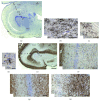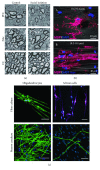Regulation of Central Nervous System Myelination in Higher Brain Functions
- PMID: 29692804
- PMCID: PMC5859868
- DOI: 10.1155/2018/6436453
Regulation of Central Nervous System Myelination in Higher Brain Functions
Abstract
The hippocampus and the prefrontal cortex are interconnected brain regions, playing central roles in higher brain functions, including learning and memory, planning complex cognitive behavior, and moderating social behavior. The axons in these regions continue to be myelinated into adulthood in humans, which coincides with maturation of personality and decision-making. Myelin consists of dense layers of lipid membranes wrapping around the axons to provide electrical insulation and trophic support and can profoundly affect neural circuit computation. Recent studies have revealed that long-lasting changes of myelination can be induced in these brain regions by experience, such as social isolation, stress, and alcohol abuse, as well as by neurological and psychiatric abnormalities. However, the mechanism and function of these changes remain poorly understood. Myelin regulation represents a new form of neural plasticity. Some progress has been made to provide new mechanistic insights into activity-independent and activity-dependent regulations of myelination in different experimental systems. More extensive investigations are needed in this important but underexplored research field, in order to shed light on how higher brain functions and myelination interplay in the hippocampus and prefrontal cortex.
Figures



Similar articles
-
Myelin plasticity and behaviour-connecting the dots.Curr Opin Neurobiol. 2017 Dec;47:86-92. doi: 10.1016/j.conb.2017.09.014. Epub 2017 Oct 17. Curr Opin Neurobiol. 2017. PMID: 29054040 Free PMC article. Review.
-
Is activity regulation of late myelination a plastic mechanism in the human nervous system?Neuron Glia Biol. 2009 May;5(1-2):29-34. doi: 10.1017/S1740925X09990330. Epub 2009 Sep 29. Neuron Glia Biol. 2009. PMID: 19785923 Review.
-
Social Experience-Dependent Myelination: An Implication for Psychiatric Disorders.Neural Plast. 2015;2015:465345. doi: 10.1155/2015/465345. Epub 2015 May 19. Neural Plast. 2015. PMID: 26078885 Free PMC article. Review.
-
Function and Mechanism of Myelin Regulation in Alcohol Abuse and Alcoholism.Bioessays. 2019 Jul;41(7):e1800255. doi: 10.1002/bies.201800255. Epub 2019 May 16. Bioessays. 2019. PMID: 31094014 Free PMC article. Review.
-
A new mechanism of nervous system plasticity: activity-dependent myelination.Nat Rev Neurosci. 2015 Dec;16(12):756-67. doi: 10.1038/nrn4023. Nat Rev Neurosci. 2015. PMID: 26585800 Free PMC article. Review.
Cited by
-
Hydrogen peroxide in breast milk is crucial for gut microbiota formation and myelin development in neonatal mice.Gut Microbes. 2024 Jan-Dec;16(1):2359729. doi: 10.1080/19490976.2024.2359729. Epub 2024 May 30. Gut Microbes. 2024. PMID: 38816999 Free PMC article.
-
Pathophysiology in cortico-amygdala circuits and excessive aversion processing: the role of oligodendrocytes and myelination.Brain Commun. 2024 Apr 18;6(3):fcae140. doi: 10.1093/braincomms/fcae140. eCollection 2024. Brain Commun. 2024. PMID: 38712320 Free PMC article. Review.
-
Alcohol drinking during early adolescence activates microglial cells and increases frontolimbic Interleukin-1 beta and Toll-like receptor 4 gene expression, with heightened sensitivity in male rats compared to females.Neuropharmacology. 2021 Oct 1;197:108698. doi: 10.1016/j.neuropharm.2021.108698. Epub 2021 Jul 9. Neuropharmacology. 2021. PMID: 34252404 Free PMC article.
-
Function of GSK‑3 signaling in spinal cord injury (Review).Exp Ther Med. 2023 Oct 3;26(5):541. doi: 10.3892/etm.2023.12240. eCollection 2023 Nov. Exp Ther Med. 2023. PMID: 37869638 Free PMC article. Review.
-
Elevated NEGR1 in brain induces anxiety or depression-like phenotypes and synaptic dysfunction.Mol Psychiatry. 2025 May 17. doi: 10.1038/s41380-025-03052-7. Online ahead of print. Mol Psychiatry. 2025. PMID: 40382479
References
Publication types
MeSH terms
Grants and funding
LinkOut - more resources
Full Text Sources
Other Literature Sources

